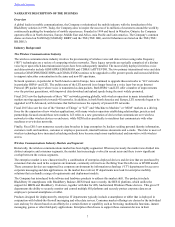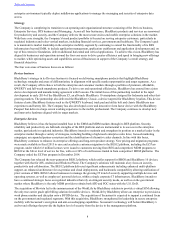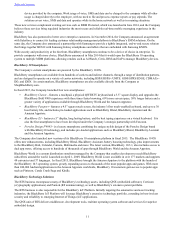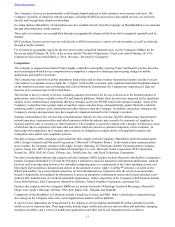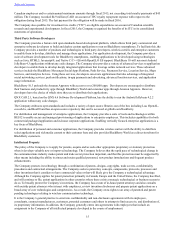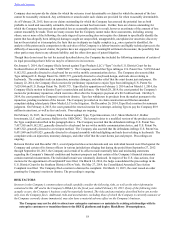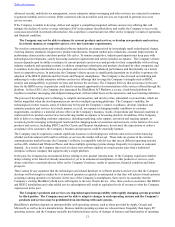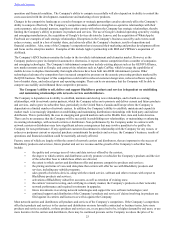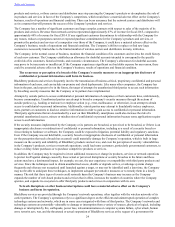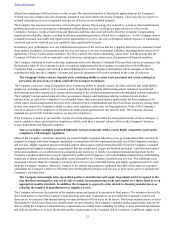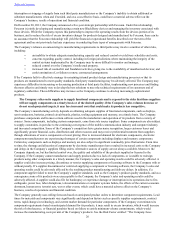Blackberry 2015 Annual Report Download - page 25
Download and view the complete annual report
Please find page 25 of the 2015 Blackberry annual report below. You can navigate through the pages in the report by either clicking on the pages listed below, or by using the keyword search tool below to find specific information within the annual report.
Table of Contents
16
The Company also enters into various types of licensing agreements related to technology and intellectual property rights. The
Company enters into certain of these agreements to obtain rights that may be necessary to produce and sell products into the
wireless industry. The Company may also license its technology and intellectual property to third parties through various
licensing agreements, including as part of the BTS business.
Production
The Company outsources the majority of its manufacturing to specialized global EMS companies who are positioned to meet
the volumes, scale, cost and quality requirements of the Company. The Company strives to reduce its risk and dependency on
these companies by having various partners located in key geographical locations, thereby increasing leverage on cost, quality
and operational performance. Constant and immediate access to each manufacturing facility is available upon the Company’s
demand, and these facilities are regularly audited by Company personnel trained in this function. The Company also operates a
production facility in Waterloo, Ontario that is primarily focused on new product introduction and research and development
related activities. In fiscal 2015, the Company sold its product development center in Bochum, Germany.
The Company expects to continue to evolve its supply chain model, including through its partnership with Foxconn, as well as
other key suppliers. Under this partnership, Foxconn has jointly developed and is manufacturing the BlackBerry Z3
smartphone for Indonesia and other fast-growing markets and delivered the BlackBerry Classic. The devices manufactured by
Foxconn are purchased and resold by BlackBerry. The Company expects the partnership with Foxconn will continue to enable
the Company to focus on iconic design, world-class security, software development and enterprise mobility management while
simultaneously addressing fast-growing markets, leveraging Foxconn’s scale, efficiency and supply chain to allow the
Company to compete more effectively while reducing the Company's inventory risk. The Company’s hardware model also
strives to provide a supply chain with speed advantages in designing for faster product life cycles, as well as to leverage scale
and manufacturing strength beyond current volumes.
The Company will also look to continue to enhance its new product introduction and supply chain planning activities through
further integration with internal research and development activities.
The Company generally controls sourcing decisions for materials and services that are incorporated into Company products.
Outsourced manufacturing partners are responsible for transacting business on behalf of the Company with component
suppliers, but the Company generally negotiates pricing of these materials and services. Depending on market conditions, the
Company may order more or less of a particular material or service and when possible, attempts to source components from at
least two suppliers with a view to avoiding different types of supply disruption. Component availability and pricing of
components may also be affected by the volumes the Company generates, compared to the volumes a competitor may require.
See also “Risk Factors - The Company relies on its suppliers to supply functional components and is exposed to the risks that
these suppliers will not supply components on a timely basis or of the desired quality; if the Company’s sales volumes decrease
or do not reach projected targets, it may face increased costs that could make its products less competitive.”
Industry Associations
The Company is an active participant in numerous industry associations and standards bodies. The Company’s involvement
with leading associations includes standards development, government advocacy, joint marketing, participation in conferences
and trade shows, training, technology licensing by the Company and business development.
Regulatory Matters
In addition to the regulatory requirements applicable to any business, an access device manufacturer must obtain certification
from the radio/telecommunications regulatory authorities in most jurisdictions before commencing commercial sale of its
products in those jurisdictions.
The Company’s products must be approved by the Federal Communications Commission (“FCC”) before they can be used in
commercial quantities in the United States. In Canada, the relevant regulatory authority is Industry Canada. The European
Community (“EC”) defines marking requirements within the Radio and Telecommunications Terminal Equipment (“R&TTE”)
Directive for use in EC member states. Regulatory requirements are similar in other jurisdictions. All regulators require access
devices to meet various standards, including limits with respect to interference with other electronic equipment and safety
standards with respect to human exposure to electromagnetic radiation.
The Company’s BlackBerry wireless devices, which are made commercially available by the Company across multiple
markets, meet FCC, Industry Canada, and R&TTE requirements. In addition, Company devices have obtained regulatory
approvals required by other countries where such products are made commercially available by the Company. As BlackBerry
has started to design and market devices in selected regions only, not every device will meet FCC, Industry Canada and
R&TTE requirements. Devices developed under the Foxconn partnership will be tested by BlackBerry internal or external labs
holding the required regulatory certifications.



